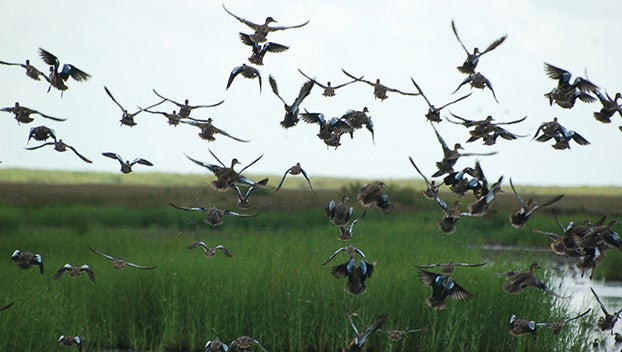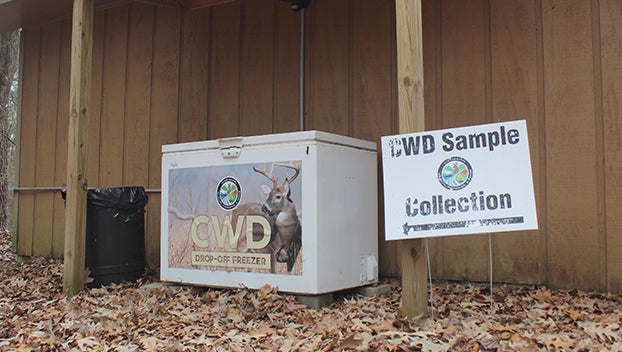Louisiana Waterfowl Program looks ahead to season with positive outlook
Published 1:48 pm Monday, August 28, 2023

- Blue-winged teal are the first migratory waterfowl species to arrive in the fall (photo by Ruth Elsey)
|
Getting your Trinity Audio player ready...
|
NATCHEZ — Duck season is nearly back in Louisiana, and the offseason is almost over. Louisiana Waterfowl Program Director Jason Olszak returned from the Mississippi Flyway Council meeting Monday and looks ahead to the early teal season.
The council discussed the United States Fish and Wildlife Service 2023 Waterfowl Survey results from the prairie pothole region. USFWS’s survey was published on August 18, 2023, marking a step closer to the hunting season.
Each year, the USFWS releases a survey conducted in May of the ducks returning to the breeding grounds in the prairie pothole region containing Manitoba, Saskatchewan Provinces and North Dakota. A majority of ducks hunted in Louisiana and the Mississippi Flyway are bred in this region.
Olszak said he was a bit surprised by the results. Overall, ducks were at an abundance of 32.32 million. He had higher expectations for the 2023 survey, but a lot of the prairie conditions were still dry. Olszak said he remained hopeful the breeding population would produce a good brood of juvenile ducks.
“I heard there were exceptional conditions in the Dakotas for the dabbling ducks. A recent brood survey showed increases in brood numbers. Juvenile birds will be more of what we shoot,” Olszak said. “I’m not a doomsayer. I still have some high expectations. The pintail rebound was a surprise to me. They breed further west and north and will move to new areas to breed sometimes. Pintails are an enigma. I was not expecting a 25 percent jump, but it happened.”
Pintails bounced back 24 percent from 2022 survey numbers with 2.2 million birds. The population remains 43 percent below the long-term average.
Olzsak said the Mississippi Flyway Council made a recommendation to maintain a liberal duck season with a 60-day season and 6-duck limit. All species-specific bag limits will remain the same in 2024.
The mottled duck bag limit will have a change this season. Olzsak said mottled ducks can not be hunted for the first 15 days of the regular duck season from November through January. The bag limit for mottled ducks is 1 per day for the rest of the 45 days of duck season.
Studies have found that 50 percent of the mottled duck population is harvested in Louisiana during the first 15 days of the season. Mottled ducks have had challenges in population, and Louisiana is taking a cautious approach to management.
Early teal season
Green-winged teal had a good year. The population increased by 16 percent from 2022 and increased by 15 percent compared to the long-term average. Teal are one of the top 3 harvested ducks in Louisiana every year.
Early Teal season will open in Louisiana on September 15 and last 16 days. Olszak said they look forward to the Early Teal season and have been known to shoot blue-winged teal into the “big” duck season from November to January. Teal are an important species to Louisiana waterfowl hunting, but there are some habitat concerns at home.
“Green-winged teal were up in the report, but blue-winged teal were down 20 percent. Brood reports are really good from that core breeding area,” Olszak said. “The dry spell is a concern for us. Marshes are drying up, and our rain has been pretty spotty when we get rain. Some people might think ‘If I’m the only one with water, then the ducks will be there.’ It might be the case, but a bigger thing is you need to have a broadscale wetland on the landscape. I’m concerned about north Louisiana. If they do not get rain, the birds will likely fly over and head to the coast.”
Abnormally dry conditions will concentrate birds, and the harvest would not be equal across the state. He said unless they get a bunch of rain, managers might have to pump a lot of water, which could be an economic gamble.
Teal are beginning the migration south towards Mexico. The shorter photoperiod triggers the move, but a cold front up north helps push the birds south as well. Olszak said he has heard reports of teal already in Louisiana.
“Most of the teal here right now are males. They don’t have any responsibilities after breeding and head south earlier. A trickle of birds is not uncommon in August,” Olszak said. “I talked to some colleagues in northern states, and they are starting to see more. I would expect it to pick up little by little. The peak migration for Louisiana is not until late September, so we try to set the teal season dates for as late as we can in September.”
Rails and gallinules, birds which live in the marshes, will be open for harvest during the teal season. They live in Louisiana during the spring and summer, so your best chance at hunting rails or gallinules is during the September season.
One way duck hunters can prepare for the fast rocketing teal is dove season. Louisiana’s opening day is September 2 for the dove season. Olszak said the heat might take a toll on hunters and dogs, so stay hydrated during the dove season opener.
“Doves seem to not be as affected by heat. The biggest effect from the heat on doves will be the productivity of plants,” Olszak said. “Millet or sunflower might not have been as productive with the heat, and there may not be as much seed on the ground.”
Conservation efforts
Duck hunters and waterfowl enthusiasts can continue to support waterfowl populations by purchasing duck stamps, hunting licenses and the federal duck stamp. Louisiana’s duck stamp and waterfowl license go towards habitat projects and research in the state. Federal duck stamp funding goes to the pothole prairie region to acquire needed habitat for ducks.
“It is in essence, the best thing people can do for ducks,” Olszak said. “Those who own land and can manage it can continue to do it. Or if you do not, you can seek advice on managing habitat, food and hunting pressure. We offer programs with technical guidance along with the Natural Resource and Soil Conservation, USFWS and Ducks Unlimited.”






